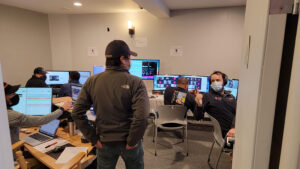Google I/O Event Recap
Google had the herculean task of transforming I/O, their flagship developer conference, into a virtual event and called us up. Though we knew that we were about to be confronted with several logistical challenges, we were ready to take them on and succeed.
Argus HD has years of experience producing A/V experiences for in-person and providing video services for the past several I/O conference. We’ve also spent the past year creating custom workflows for Google’s virtual Developer Summits and Conferences.
Pre-Production Process
Google entrusted Argus HD with several unique challenges. The first problem we had to tackle: the question of rehearsal logistics. How do we schedule more than 100 rehearsal events with presenters from all over the globe? How do we automate the process for the guests so they can join with a single click? How do we create, manage, and track schedules and content from rehearsal through post-production? On the production side, with a show of this complexity — more than fifty separate sessions across three days and nine YouTube channels — how do we distill a plethora of information and onboard dozens of technicians to the show with easy and clear access to relevant information without any clutter?

As if this wasn’t enough of a challenge, each of our four studios each had to produce two styles of shows, each with their own pre-produced graphics, formats, and challenges, all of which needed to be readied, checked, and double-checked. This was going to be no small challenge.
Our solutions: cross-linking documentation, making use of automation and scripts, and incredibly thorough preparation. Beginning months before the event, we worked closely with Google to utilize their tools. From this, we built custom documents — many of which imported and updated information from other documents —and set up automated tasks, such as importing information live from calendars, client trackers, and YouTube events, to make the process easy for everyone involved. With hundreds of links generated, changed, and rescheduled, having every document be a “living doc” made the seemingly impossible possible.
Our final innovation was to create “dashboards” for each studio. Each of these dashboards could automatically update all relevant and current information from rehearsal to show day. This ensured that everyone, in every department, had access to the most current information. For example, technicians in Studio 1 only saw information relevant to the events that it would stream, in chronological order, while each of the remaining three studios saw only information relevant to them, all automatically generated.
Dialing In the Studios
Once pre-production was complete, we transitioned to the complicated task of dialing in our four broadcast studios — three primary studios which would stream more than fifty sessions across nine channels, some with millions of subscribers, over three days — plus a fourth “hot backup” studio, ready to take over if anything went wrong.


Each control room was based around a video switcher, a graphics system, and two sets of 4 “inbound” contribution inputs. The studio technical directors were given the ability to switch which inbound inputs they would receive in between shows. That way, we could welcome and set up the presenters for one session while another session was broadcasting live from the same studio.
To make the presenters feel as at ease as possible, we committed to a system that used software they already knew and used, keeping things as simple as possible. As a result, we chose to use as our teleconferencing service Google Meet, as we have, over more than a year of virtual event production, used it to refine the method that brought these remote guests into the production switcher environment.
Show Day
Argus needed a plan that allowed scaling of our production capacity as the event needs evolved. Because we needed to stream to so many channels, and because each session required a live stenographer to provide closed captioning, it would have been impractical for each studio to stop streaming between sessions to change which channel they’d be streaming to. Building on a workflow we developed for other Google events, our solution was simple, scalable, and elegant: each studio would stream to a Content Delivery Network (CDN), each of which could broadcast the stream to every channel simultaneously. All our technical directors had to do was open the dashboard for the next session, and hit “Go Live.” By putting in the preparation, we made things simple for everyone involved on show day. This greatly minimized the opportunity for human error, and every session started and ended exactly on time.
Google I/O was broadcast to a global audience, with key constituencies in the Europe Middle East and Africa (EMEA) and Asia Pacific (APAC) regions.
Let Argus HD Help You with Your Virtual Event
As virtual events continue to merge to with in-person, hybrid events will continue to grow in popularity and necessity. The complexity and importance of merging these events should not be underestimated. However, you need not be intimidated. When you have an upcoming event that includes virtual elements, either in whole or in part, please feel free to reach out with questions. We would be delighted to work with you.
We hope you enjoyed learning a little bit about our process and we hope to hear from you soon!


